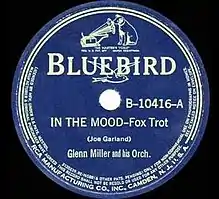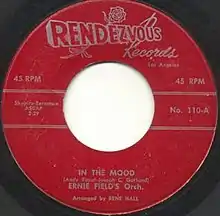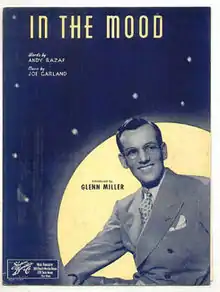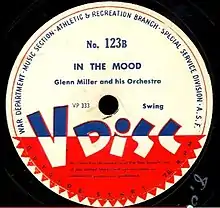In the Mood
"In the Mood" is a popular big band-era jazz standard recorded by American bandleader Glenn Miller. It was featured in the movie Sun Valley Serenade and in an episode of the British science fiction series Doctor Who. "In the Mood" is based on the composition "Tar Paper Stomp" by Wingy Manone. The first recording under the name "In the Mood" was released by Edgar Hayes & His Orchestra in 1938.
| "In the Mood" | |
|---|---|
 | |
| Single by Glenn Miller and His Orchestra | |
| B-side | "I Want to Be Happy" |
| Released | 15 September 1939 |
| Recorded | 1 August 1939 |
| Genre | Big band, swing |
| Length | 3:40 |
| Label | Bluebird |
| Songwriter(s) | Wingy Manone (c), Andy Razaf (w), Joe Garland (a) |
| "In the Mood" | ||||
|---|---|---|---|---|
 | ||||
| Single by Ernie Fields | ||||
| B-side | "Christopher Columbus" | |||
| Released | October 1959 | |||
| Genre | Jazz | |||
| Length | 2:29 | |||
| Label | Rendezvous | |||
| Songwriter(s) | Wingy Manone (c), Andy Razaf (w), Joe Garland (a) | |||
| Ernie Fields singles chronology | ||||
| ||||
In 1983, the Glenn Miller recording from 1939 was inducted into the Grammy Hall of Fame. In 2004, the recording was inducted into the Library of Congress National Recording Registry which consists of recordings that are "culturally, historically, or aesthetically significant."
In 1999, National Public Radio (NPR) included the 1939 Glenn Miller recording in its list of "The 100 most important American musical works of the 20th century".[1][2]
Glenn Miller's "In the Mood", with "I Want to Be Happy" on the B-side, became the best-selling swing instrumental.[3][4]
Arrangement
"In the Mood" starts with a saxophone section theme based on repeated arpeggios that are rhythmically displaced; trumpets and trombones add accent riffs. The arrangement has two solo sections: a "tenor fight" or chase solo—in one recording between Tex Beneke and Al Klink—and a 16-bar trumpet solo by Clyde Hurley.[5] At the end of the song, a coda climbs triumphantly, then sounds a sustained unison tonic pitch with a rim shot.[3]
History
"In the Mood" was an arrangement by Joe Garland based on an existing melody. Lyrics were added by Andy Razaf. The main theme with repeated arpeggios rhythmically displaced appeared under the title "Tar Paper Stomp" and was credited to trumpeter Wingy Manone.[6] Manone recorded "Tar Paper Stomp" on August 28, 1930, in Richmond, Indiana, and released it as a 78 single for Champion Records under the name Barbecue Joe and his Hot Dogs. It was re-released in 1935 by Wingy Manone's Orchestra.[7]
Horace Henderson used the same riff in "Hot and Anxious", which was recorded by his brother Fletcher Henderson on March 19, 1931, for Columbia under the name the Baltimore Bell Hops. Don Redman recorded "Hot and Anxious" for Brunswick in 1932.
Under copyright laws, a tune that had not been written down and registered with the copyright office could be appropriated by any musician with a good ear. Manone raised the similarity between "Tar Paper Stomp" and "In the Mood" to Joe Garland and to the publisher Shapiro, Bernstein, and Company of New York.[8] Manone also discussed the issue in DownBeat magazine.
"Tar Paper Stomp" was copyrighted on November 6, 1941, as a pianoforte version by Peer International.[9]
The first recording of Joe Garland's version of "In the Mood" was made by Edgar Hayes and his Orchestra in 1938 with Garland participating. It was released as a B side to their recording of "Stardust" for Decca. On this recording there was a baritone saxophone duet rather than a tenor saxophone battle. The riff had appeared in a 1935 recording by the Mills Blue Rhythm Band entitled "There's Rhythm in Harlem", which had been composed and arranged by Garland. Before offering it to Miller, Garland sold it in 1938 to Artie Shaw, who chose not to record it because the original arrangement was too long, but he did perform it in concert.[10]
Artie Shaw's version was over six minutes long and met a lackluster audience response.[8] Jerry Gray arranged Shaw's version. The band later performed a shorter version. The Hayes recording was over three minutes in length to fit on one side of a 78 record.
The song was sold in 1939 to Glenn Miller, who experimented with the arrangement. The author of the final arrangement is unknown. One possibility is Eddie Durham because he wrote other arrangements on the same day that "In the Mood" was recorded. Other possibilities include pianist Chummy MacGregor, who was Miller's chief arranger, John Chalmers, and Miller himself. According to an account by MacGregor, "all they used of the original arrangement were the two front saxophone strains and another part that occurred later on in the arrangement."[11] Both MacGregor and Miller were involved in creating the final arrangement: "MacGregor mentioned that additional solos were added to the original arrangement and he wrote the finishing coda. Miller probably edited some of the arrangement along with MacGregor."[11][12]
Two editions of the sheet music are in circulation. The 1939 publication credited to Garland and Razaf is in A♭ and has lyrics beginning: "Mister What-cha-call-em, what-cha doin' tonight?" The 1960 reprint credited only to Garland (with piano arrangement by Robert C. Haring) is in G and has lyrics beginning: "Who's the livin' dolly with the beautiful eyes?"
The personnel on Miller's recording included Al Mastren and Paul Tanner on trombone; Clyde Hurley, Legh Knowles, and Dale McMickle on trumpet; Wilbur Schwartz on clarinet; Hal McIntyre on alto saxophone; Tex Beneke, Al Klink, and Harold Tennyson on tenor saxophone; Chummy MacGregor on piano; Richard Fisher on guitar; Rowland Bundock on double bass; and Moe Purtill on drums.[13]
Other versions

In February 1944, the Glenn Miller RCA Victor Bluebird 1939 studio recording of "In the Mood" was released as a V-Disc, one of a series of recordings sent free by the U.S. War Department to overseas military personnel during World War II. A second version recorded by Glenn Miller's Overseas Band in 1945, was released in May 1948. A new recording by Glenn Miller with the American Band of the Allied Expeditionary Forces (AEF) was broadcast to Germany in 1944 on the radio program The Wehrmacht Hour.[14]
This piece of music was not new in Europe. The first Swiss record of "In the Mood" were released in April 1940 by Teddy Stauffer und seine Original Teddies in Zurich.[15] Another interpretation was made by Ernst van't Hoff in February 1941 in Berlin.[16]
Other musicians who have performed "In the Mood" include Benny Goodman in November 1939 on the Camel Caravan radio program, Ray Anthony, Frankie Carle, Casa Loma Orchestra, Xavier Cugat, Al Donahue with Paula Kelly on vocals, Tommy Dorsey, Duke Ellington, The Four King Sisters with Alvino Rey, Harry James, Bert Kaempfert, Nappy Lamare, James Last, Joe Loss, Sid Ramin, The Brian Setzer Orchestra, Doc Severinsen, Artie Shaw, The Shadows, Bill Haley and His Comets, The Andrews Sisters (with lyrics), John Williams with the Boston Pops Orchestra,[17] and Pat Travers.
In 1951 a Ferranti Mark 1 computer at the University of Manchester played "In the Mood", one of the first songs to be played by a computer, and the oldest known recording of digitally generated music.[18]
In December 1959, the rendition of "In the Mood" that Ernie Fields and his Orchestra recorded peaked at number 4 by means of the Billboard popular hit parade and number 7 by means of both the Rhythm and Blues [19] and the Cash Box hit parades.
In the winter of 1977, a novelty version by the Henhouse Five Plus Too employing the sounds of clucking chickens entered the U.S. Pop Top 40: (Billboard No. 40,[20] Cash Box #37[21]).
In 1983, the Glenn Miller Orchestra, conducted by Larry O'Brien, recorded the album In the Digital Mood which included the song.[22]
John Lee Hooker said that "In the Mood" was the inspiration for his song "I'm in the Mood" which became a No. 1 hit on the R&B Singles chart.[23]

See also
References
- "NPR 100". www.npr.org. Retrieved 10 November 2018.
- NPR 100. The 100 most important American musical works of the 20th century.
- Gilliland, John (1994). Pop Chronicles the 40s: The Lively Story of Pop Music in the 40s (audiobook). ISBN 978-1-55935-147-8. OCLC 31611854. Tape 2, side A.
- Gioia, Ted (2012). The Jazz Standards: A Guide to the Repertoire. New York City: Oxford University Press. pp. 185–186. ISBN 978-0-19-993739-4.
- Oliphant, Dave (15 June 2010). "Hurley, Clyde Lanham, Jr". tshaonline.org. Retrieved 11 November 2018.
With Miller Hurley was recorded playing perhaps the orchestra's most famous solo, the one for trumpet on Miller's 'In the Mood'.
- Updike, John (2009). The Widows of Eastwick. Ballantine Books. pp. 262–. ISBN 978-0-345-51751-7. Retrieved 10 November 2018.
- "Barbecue Joe and his Hot Dogs". www.redhotjazz.com. Retrieved 10 November 2018.
- Sullivan, Steve (4 October 2013). Encyclopedia of Great Popular Song Recordings. Lanham, Maryland: Scarecrow Press. pp. 50–. ISBN 978-0-8108-8296-6. Retrieved 10 November 2018.
- Catalog of Copyright Entries: Musical compositions. Library of Congress, Copyright Office. 1942. pp. 112–. Retrieved 10 November 2018.
- Rickert, David (27 December 2005). "Glenn Miller: In the Mood". All About Jazz. Retrieved 10 November 2018.
- Flower, John (1972). Moonlight Serenade: A Bio-discography of the Glenn Miller Civilian Band. New Rochelle, New York: Arlington House. pp. 79–81. ISBN 0-87000-161-2.
- Grudens, Richard (2004). Chattanooga Choo Choo: The Life and Times of the World Famous Glenn Miller Orchestra. Stonybrook, New York: Celebrity Profiles Publilshing. pp. 198–. ISBN 978-1-57579-277-4. Retrieved 10 November 2018.
- Jasen, David A. (1 June 2004). Tin Pan Alley: An Encyclopedia of the Golden Age of American Song. New York, New York: Routledge. pp. 1–. ISBN 1-135-94900-X. Retrieved 10 November 2018.
- In the Mood (U.S. government German-language broadcast recording). learnnc.com.
- Heiner Bontrup, E. Dieter Fränzel: Wiederentdeckung einer Swing-Legende. Die Ernst Höllerhagen Story. Ein Jazzmusiker zwischen Nationalsozialismus und Wirtschaftswunder. Mit Diskographie 1934−1955. Nordpark, Wuppertal 2011, ISBN 978-3-935421-42-3, p. 141.
- "In the Mood", Orchester Ernst van't Hoff, Polydor 47522, Matrix number 8925 GD-2, produced in Berlin, February 1941
- Second Hand Songs.
- BBC World 17 June 2008, "Oldest computer music unveiled"
- Whitburn, Joel (2004). Top R&B/Hip-Hop Singles: 1942-2004. Record Research. p. 201.
- Joel Whitburn's Top Pop Singles 1955–1990 - ISBN 0-89820-089-X
- "Cash Box Top 100 Singles, February 19, 1977". Archived from the original on October 20, 2018. Retrieved December 29, 2017.
- Eder, Bruce. "In the Digital Mood". AllMusic. Retrieved August 27, 2020.
- The Very Best of John Lee Hooker. Rhino Records R2 71915. Liner Notes, Pg.7